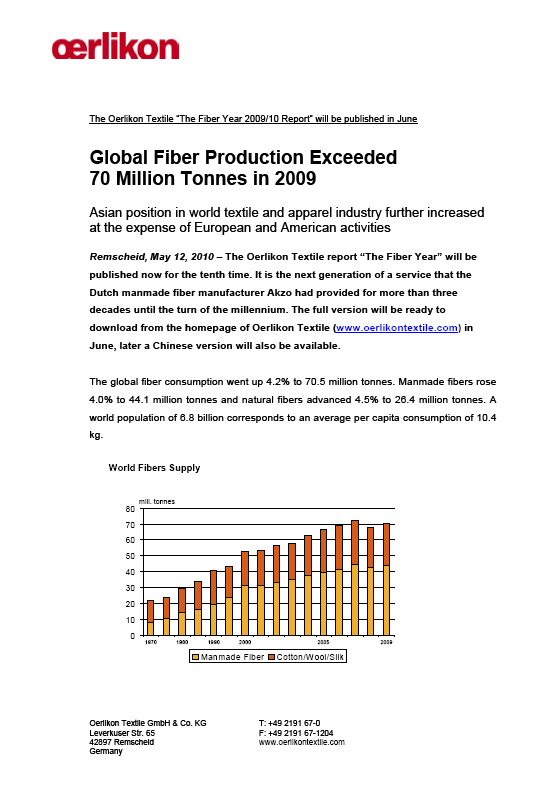
GRP is finally back on track
The Oerlikon Textile report ‘The Fiber Year’ which is being published for the tenth time will be available for download from the company’s homepage www.oerlikontextile.com in June. A Chinese version of the report will be available at a later date. According to the report, global fibre consumption went up 4.2% to 70.5 million tonnes with manmade fibres rising 4.0% to 44.1 million tonnes and natural fibres advancing 4.5% to 26.4 million tonnes. With a world popula

13th May 2010
Innovation in Textiles
|
Remscheid
 The Oerlikon Textile report ‘The Fiber Year’ which is being published for the tenth time will be available for download from the company’s homepage www.oerlikontextile.com in June. A Chinese version of the report will be available at a later date.
The Oerlikon Textile report ‘The Fiber Year’ which is being published for the tenth time will be available for download from the company’s homepage www.oerlikontextile.com in June. A Chinese version of the report will be available at a later date.
According to the report, global fibre consumption went up 4.2% to 70.5 million tonnes with manmade fibres rising 4.0% to 44.1 million tonnes and natural fibres advancing 4.5% to 26.4 million tonnes. With a world population of 6.8 billion, this corresponds to an average per capita consumption of 10.4 kg.
The report says that while the return to growth in 2009 is a positive thing, the entire textile and apparel industry has lost a huge manufacturing and processing volume in the last two years.
Taking into account the long term average annual growth rate of 3.4%, the demand shortfall in the last two years adds up to 15 million tonnes. As lower priced apparel was available across the world after China’s accession to WTO at the end of 2001, the short term average annual growth rate even accounts for 5.2%. This annual growth rate lead to a demand shortfall in the last two years of 19 million tonnes.
The following is a summary from the report for each of the major fibre types:
According to the report, the current season’s world cotton production is expected to decline 4.8% to 22.3 million tonnes. “The increasing approval and cultivation of genetically modified cotton had resulted in soaring cotton yields. In the season 2003/04, actual cotton production started to outpace the long-term trend. Current season’s output returned to the long-term trend due to 3.5% lower yields per hectare in the actual season and the fifth consecutive seasonal decline in cotton area. In contrast, global consumption is projected to rise 5.4% to 25.2 million tonnes,” the report says.
World wool production fell 7.4% at 1.1 million tonnes clean weight in 2009, marking the seventh annual decline in the past decade. Apparel wool witnessed the steepest drop in production, falling 8% to 552,000 tonnes, while production of wool used in interior textiles fell 6% to 547,000 tonnes.
Almost half the world output comes from Australia, PR China and New Zealand. All countries reported declines for different reasons. Drought in eastern Australia and high sheep meat prices resulted in 9.5% lower output at 257,000 tonnes and have pushed sheep numbers down to around 72 million head, the lowest since the 1920s.
As 90% of Australia’s wool is used in clothing, it is the world’s largest supplier of apparel wool, accounting for around 50% of world production. Production in the second largest wool producing country, PR China, fell by 6.9% to 0.16 million tonnes. This is the lowest production level in China since 2003.
There is a move away from woolled sheep in China to take advantage of high sheep meat prices. In New Zealand, the world’s largest producer of wool for interior textiles, production fell by 23.5% to 119,000 tonnes clean. The main driver of this decline was the sell-off of sheep as farmers converted their properties to use for the dairy industry.
The cellulosic fibre market increased by 7.7% to 3.8 million tonnes, just marginally missing the pre-crisis’ all-time high. The filament business continued its long-term decline due to lower output in Europe and the United States, declining by 5.4% to 351,000 tonnes.
The production of viscose staple fibres soared 11.4% to 2.7 million tonnes thanks to growing demand in nonwovens, textile applications and flame retardant product despite an increasingly unfavourable price differential to polyester staple fibre. Viscose fibres strongly benefited from a shortage in cotton and an increasing requirement for comfort that cotton could not meet.
Above-average consumption became apparent in PR China and India as a result of rising household incomes. Huge investments in this sector in PR China expected to come on-stream in 2010 may give cause for serious concern related to supply of raw material and search of new sales areas needed to operate these breathtaking investments at full capacity. Steady growth momentum was provided by the subsector of acetate tows, rising 2.3% to 759,000 tonnes.
This sector’s stimulation, highly correlated to the growth of cigarette consumption, may be surprising in the light of global efforts to restrict smoking. However, growth of the market is driven primarily by population increases and rising wealth in emerging markets. Additional dynamics may arise from substitution of unfiltered cigarettes and of polypropylene-based filters as well as a marked trend towards longer cigarette filters.
The development in the synthetic fibre segment showed a mixed performance. The total market was up 3.7% to 40.3 million tonnes. Polyester production increased by 5.3% and acrylics rose 4.4%. On the other hand, polypropylene decreased by 6.5% and polyamide was down 1.4%. The manmade fiber spinning business has further declined in developed countries, while Asia continued to gain market shares. The Asian manufacturing volume of more than 36 million tonnes corresponds to a global 83% market share. The Chinese industry succeeded in lifting output by 11.2% to 26.3 million tonnes.
Polyester
The fundamental change of the polyester business has continued in favour of PR China, actually taking in a 69% share. The economic center of gravity will continue to be in PR China as several large-scale expansion projects in textile and industrial yarn markets will shortly come on-stream.
The strong growth in the polyester textile yarn production of 6.7% to 18.2 million tonnes was driven by a small number of Asian countries while the western hemisphere reported heavy declines. This has lifted the Asian market share to nearly 97%. The textile powerhouse, PR China, as well as India, Malaysia and Vietnam succeeded in increasing output substantially. The textile filament markets in Greater Europe were characterized by sluggish demand, resulting in lower manufacturing activity and imports. The region’s production volume fell 22% and the Americas suffered from a decline of 15% last year.
The industrial yarn business has suffered from the downturn in the automotive industry. The global output of polyester industrial yarn was down 6.1% to nearly 1.1 million tonnes. While production in Greater Europe dramatically fell by 44%, the Americas were down 19%. According to figures from the China Chemical Fiber Association, national output increased by 22% to 550,000 tonnes. Given reduced exports and almost unchanged imports, this calls for an amazing growth momentum in a year of great depression.
The staple business grew 4.4% to 12.6 million tonnes. The only growth region was Asia, now accounting for an 89% market share. Although the capacity growth in PR China has significantly slowed since 2005, excess supply still is an issue.
While national output rose 9% to 7.9 million tonnes, the average utilization rate was just slightly above 70% last year. India, the second largest producer, increased volumes by 15% to around 860,000 tonnes – similar to the pre-crisis level. Taiwan and South Korea, in third and fourth position, both managed to lift output as well. Taiwan’s production grew 13% to nearly 570,000 tonnes, equal to an average run rate of about 90%.
The Korean output improved by 5% to 516,000 tonnes, resulting in a utilization rate of approximately 80%. The healthy operating rates in both industries are the outcome of a persistent adjustment to the changing market environment and further reductions in capacity are planned for the years to come.
The other parts of the world all suffered from declining output. Production in Greater Europe went down by 14% to below 600,000 tonnes. While Turkey was stable, Western Europe decreased by 23% to 268,000 tonnes and CIS manufacturing activity collapsed by 18% to 82,000 tonnes. In the Americas, production declined by 15% to about 725,000 tonnes.
Polyamide
Polyamide fibres continued declining by 1.4% to 3.5 million tonnes in 2009. Continuously rising caprolactam prices, almost doubling until year-end, have resulted in increasing prices of the subsequent products. Furthermore, the depressed housing market in the United States and lower vehicle build rates have put additional strain on the industry. Despite increasing pressure from polyester, textile yarn was up by 8.3% at 1.6 million tonnes. All the other sectors suffered from decreasing activity with the industrial yarn business going down by 7.4% at 0.9 million tonnes, carpet yarn falling 8.0% to 0.7 million tonnes and staple fibre dropping by 15.7% to 214,000 tonnes.
Polypropylene
The world polypropylene market decreased by 6.5% to 2.6 million tonnes, suffering from a substantial increase in fiber grade prices from the second quarter and reduced consumer spending for home textiles. In the United States, slow demand for carpet yarn and increasing substitution by polyester have put additional pressure on the industry. While staple fiber applications increased by 3.5% to 1.1 million tonnes, output of filament yarns declined by 12.7% to 1.5 million tonnes.
Acrylic
The acrylic fibres market has seen its first growth after four years of contraction and losing a volume of around 825,000 tonnes from a record high at 2.7 million tonnes in 2004. In 2009, the global output rose 4.4% to 1.9 million tonnes. The recovery of operating rates started in Asia and reached Europe in the second quarter whereas the Americas did not witness any improvement. It was initially driven by stock rebuilding, seasonal improvement and the lowest price differential with polyester in six years.
The 2009 world output of yarns was up 4.0% to 61.8 million tonnes. The three yarn types differently benefited from the worldwide recovery in demand. Filament yarns increased 3.4% to 24.8 million tonnes, of which carpet yarns (excluding polyester carpet yarn) dropped 13.4% to 1.7 million tonnes, industrial yarns declined 6.9% to 2.4 million tonnes and textile filament yarns were up 6.4% at 20.7 million tonnes.
Short staple yarn rose 5.1% to 32.9 million tonnes and long staple yarn remained at the low level of 4.1 million tonnes. The world market of 61.8 million tonnes is being dominated by PR China. The Chinese output volume accounted for 39.7 million tonnes last year, equal to a market share of 64%. India has produced 5.7 million tonnes, occupying a 9% share.
The United States managed to achieve a manufacturing volume of 1.9 million tonnes, followed by Taiwan with 1.5 million and South Korea with 1.1 million tonnes. The rest of the world contributed 19% to the global yarn production, corresponding to 11.9 million tonnes.
The nonwovens industry has delivered a mixed performance as some sectors like personal hygiene, including adult incontinence products, feminine hygiene products and baby diapers, and medical were not impacted by the economic slowdown. Other markets like automotive, construction and home textiles, however, suffered from the slump in economic activities.
In total, last year’s output of nonwovens and unspun end-uses has increased by 6.3% to 7.1 million tonnes after a slowdown in 2008. In developed countries, growth in population and disposable income will further lead to increased spending for consumer disposables. Further, an aging population will raise the demand for medical nonwovens and adult incontinence products. Demand for better quality disposable applications will mainly come from the growing middle classes in developing countries.
The Chinese and Indian markets will continue to grow in urban areas whereas consumption in the rural areas will not increase as rapidly due to far lower income levels and for reasons of tradition. Demand for disposable products such as babies‘diapers, also true for the Middle East, will remain lower because of cheap labour, the presence of extended families and the employment of nursemaids. Finally, investments in infrastructure will assist the industrial development for geotextiles and agricultural applications.
Oerlikon is a leading high-tech industrial group specializing in machine and plant engineering. The company is a provider of innovative industrial solutions and cutting-edge technologies for textile manufacturing, thin-film coating, drive, vacuum, solar energy systems and advanced nanotechnology.
A Swiss company with a tradition going back 150 years, Oerlikon is a global player with around 16,000 employees at 157 locations in 36 countries and sales of CHF 2.9 billion in 2009. The Company invests more than CHF 200 million annually in R&D, with over 1200 specialists working on future products and services. The operative businesses rank either first or second in their respective global markets.

Business intelligence for the fibre, textiles and apparel industries: technologies, innovations, markets, investments, trade policy, sourcing, strategy...
Find out more